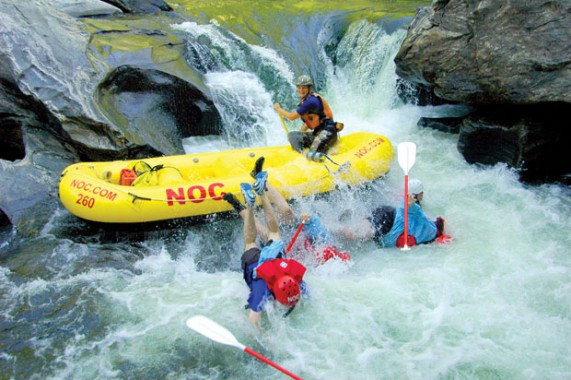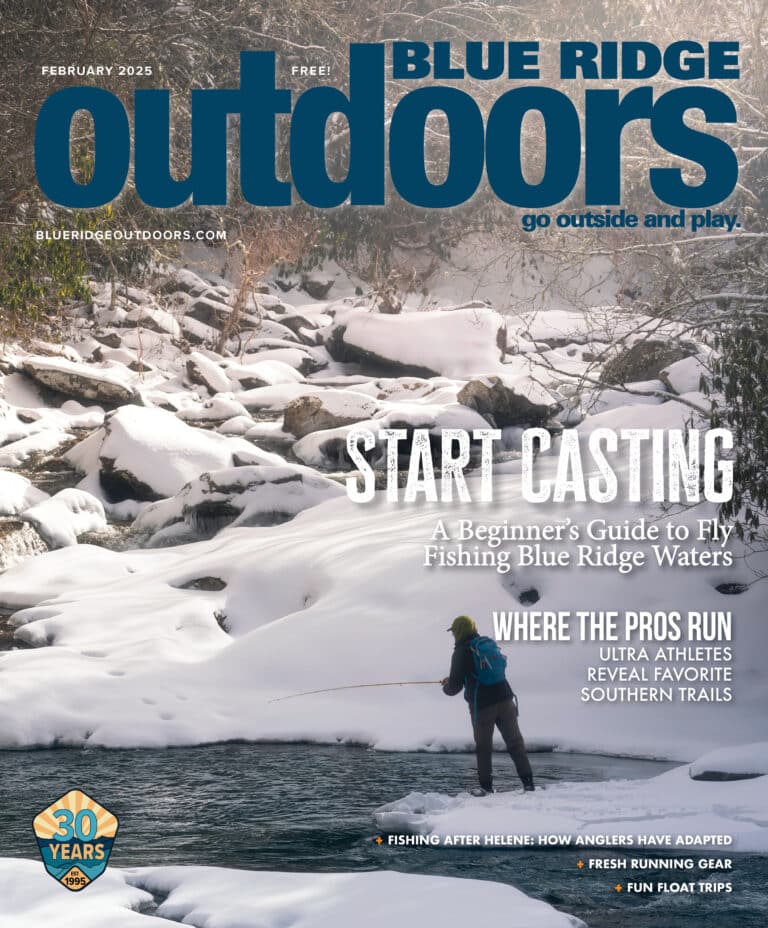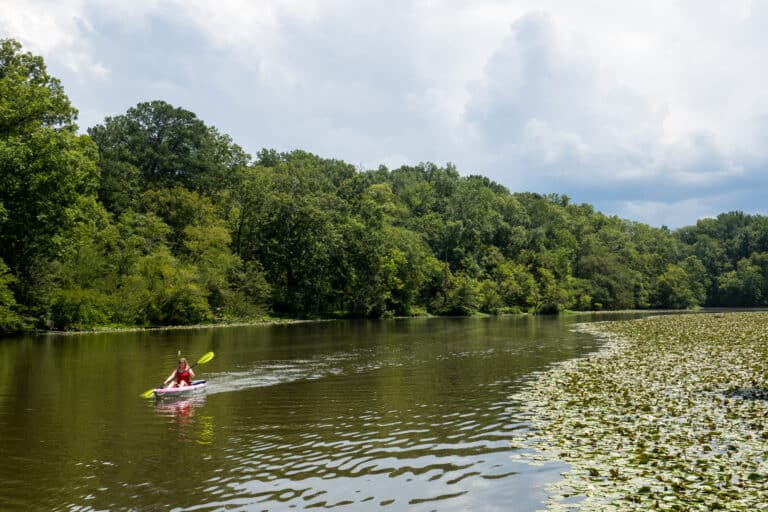Wet exit: Whitewater rafters take an unexpected swim on section IV of the Chattoga River
The first river in the South to be designated Wild and Scenic by Congress, the free-flowing Chattooga begins in the Appalachian Mountains of North Carolina as rivulets and rainwater. Flowing southwesterly, the river follows the Georgia and South Carolina border before it joins the Tallulah River and spills into Lake Tugaloo. The Chattooga flows through three national forests: Sumter, Nantahala, and Chattahoochee.
Although it is commercially rafted, the Chattooga is primitive and protected. Motorized vehicles and developments are prohibited for a quarter mile on either side of the river. You can find peace there: paddle downstream in section II and listen to the canoe softly parting the water. Tackle the class V rapids at Five Falls. Hike in the footsteps of William Bartram along the banks. Although the river lures some 100,000 visitors a year, the size of its protected corridor ensures ample solitude.
Here are three ways to fall in love with the Chattooga.
canoe section II
Bring a canoe or rent a kayak or duckie and spend a serene day paddling the calmer section of the Chattooga.
“Section II is absolutely gorgeous. It has flat, moving water with some small Class II rapids,” says Barbara Westbrook, retail manager at Chattooga Whitewater Outfitters. Look for otters, mink, and an abundance of seasonal wildflowers, including bird’s foot violet and trillium.
There are several primitive campsites on the Chattooga, first come first serve. Pick up a map at one of the local outfitters, drive down one of the dirt roads that all dead-end a quarter mile shy of the river, park your car and hike your camping gear down the trails that continue to the river. Most of the outfitters also offer a shuttle service.
paddle section IV
Immortalized by the film Deliverance, Section IV of the Chattooga boasts Class IV and V rapids. On this run, you’ll drop more than 75 feet through Five Falls: Entrance, Corkscrew, Crack-In-the-Rock, Jawbone, and Sock-Em Dog. One minute a glassy expanse, shaded by cliffs and rhododendron, and the next a rock-strewn maze. The river twists and rushes, and in a blink, she stills for you to ponder.
“You’ll see a lot of birdlife,” says Carolyn Allison, assistant marketing director for Wildwater Rafting, one of the three outfitters on the river. “Great blue herons travel up and down the river, and sometimes a pair of Canada geese will follow a trip downstream. Of course, you’ll also see mountain laurel and rhododendron, and what natives call swamp azalea.”
Actually, you’ll smell it first.
“They’re a pretty bright pink bloom,” says Allison, “and in the spring, the swamp azalea is incredibly fragrant. You can smell it wafting down the river.”
Allison says late spring is an ideal time to paddle the river: “The water level is high and the river is warm enough to take a dip, but it’s not blistering hot.”
The Chattooga has only three rafting companies: the Nantahala Outdoor Center’s Chattooga outpost, Southeastern Expeditions, and Wildwater. Together they run a tight river schedule that protects the wild and scenic values. Because of their strict launch times, visitors shouldn’t see too many others on the river, whether you’re paddling alone or with a guide.
hike the Bartram trail
When John Ray retired, he found that hiking the Bartram Trail was complicated. Overgrown and unmarked, the Georgia portion of the national trail named after naturalist William Bartram needed attention. So Ray founded the Georgia Bartram Trail Group, and since 1999, he has worked with the U.S. Forest Service and volunteers to improve and maintain the trail. Over 37 miles in its entirety, the trail is part of the Chattahoochee National Forest.
Ray recommends a day hike down a section of the trail that takes you along the Chattooga, with a short side trail down to Dick’s Creek Falls. “The granite face makes the river so clear,” says Ray. “And the views are just spectacular.”
From Clayton, follow Warwoman Road east for just under 6 miles. Veer right onto Sandy Ford Road, where you’ll park on the left before the Forest Service sign for the Bartram Trail. Take a left on the trail, which is marked with yellow diamonds.
A half mile down the trail, you’ll cross a wooden bridge over Dick’s Creek. Follow the lime green blazes to Dick’s Creek Falls. Hike back up to the Bartram and follow the trail until it runs along the river. Although there are no designated sites, you can find open spaces to camp along the trail.
The legacy of Deliverance
“Just about the last wild, untamed, unpolluted… river in the South,” are among the opening lines of the 1972 film Deliverance. Called the Cahulawassee in the film, the Chattooga river was the gorgeous and formidable location for much of the film. This year marks the 40th anniversary of Deliverance, and the river has never been more popular.
The evolution of the Chattooga’s popularity as a recreational destination seem inextricably linked with the release of Deliverance. The film played on the universal fear of the unknown, represented hauntingly by the backwoods of an imagined river. The legacy the fictional characters of Aintry left behind, especially the vile, uneducated, stranger-in-the-woods, was an unwelcome endowment for the real people of Rabun County that lasted long after the movie had been filmed.
But even as it shrouded the river in foreboding, Deliverance introduced the Chattooga to an America that hungered for wilderness. And clearly still does, if the 100,000 visitors each year are any indication. For all its controversy, the ripples of Deliverance created an opportunity for more people to experience that “wild, untamed” river that Lewis so desperately wanted to share.
Don’t miss the Chattooga River Festival, June 22-24, where you can see the 40th Anniversary Deliverance Premiere.








